Myron G. Best. Igneous and metamorphic 2003 Blackwell Science
Подождите немного. Документ загружается.

Additional factors that can be of local significance in
the thermal history of orogens include magmatic and
strain heating, advective transfer of heat via fluids, and
the heat budget of mineral reactions.
Several means are available to construct P–T paths
in a rock or suite of cogenetic rocks for the terrane
in which they were metamorphosed. Broad paths are
defined by facies series and metamorphic zones.
Thermobarometry on mineral assemblages and zoned
minerals can yield quantitative data but caution must
be exercised because of disequilibrium effects resulting
from sluggish kinetics and overprinting. Further con-
straints are provided by mineral inclusions in poikilo-
blasts and other relic mineral assemblages preserved
in reaction textures; these assemblages can be placed
in petrogenetic grids derived from experimental and
thermodynamic data. High temperatures and complete
mineral equilibration at peak metamorphic conditions
can all but eliminate the prograde path record; for this
reason, retrograde paths are generally more readily
determined.
Chronologic data at specific P–T points in the meta-
morphic path permit construction of a complete P–T–t
path; such information provides quantitative estimates
of rates of mineral growth and of burial and exhuma-
tion during metamorphism.
Orogens and the metamorphic terranes in them are
infinitely variable in detail. Some Mesozoic–Cenozoic
orogens of the circum-Pacific have paired belts with
high P/T metamorphism developed in the accretionary
wedge and intermediate- to low-P metamorphism
farther inland coincident with the magmatic arc. Most
orogens, however, are not so simple because of multi-
ple episodes of docking and suturing of island arcs,
oceanic plateaus, ophiolite, and continental fragments
onto overriding continental plates. Some orogens ex-
perienced culminating continent–continent collisions
and suturing, only to be later affected by crustal exten-
sion and rifting.
The classic Barrovian metamorphic zones devel-
oped in pelitic rocks at intermediate pressures have
been a standard reference for regional metamorphism
in orogens since the work of George Barrow in the
Scottish Highlands a century ago. Successive prograde
appearance via continuous and discontinuous reactions
of chlorite, biotite, garnet, staurolite, kyanite, sillima-
nite, and sillimanite K-feldspar ( migmatite) define
these Barrovian zones. Higher grade minerals and
assemblages of the granulite facies found in other
terranes around the world include cordierite, spinel,
sapphirine, and orthopyroxene K-feldspar in lieu of
biotite.
Widespread metabasites in Barrovian terranes have
fewer phases formed by mostly continuous reactions,
hindering definition of P–T conditions from mineral
assemblages. Greenschist-facies metabasites in chlorite
and biotite pelite zones contain epidote chlorite
actinolite albite quartz calcite titanite
Fe–Ti oxides. In the garnet zone, aluminous horn-
blende replaces actinolite, oligoclase replaces albite,
and almandine-rich garnet may also appear. Chlorite
and epidote disappear in the amphibolite facies (stau-
rolite, kyanite, and sillimanite zones) and pyroxenes
replace hornblende as the dominant mafic phase in the
granulite facies.
Intermediate-P metamorphism defines open-loop,
clockwise P–T paths in orogens where the continental
crust is thickened and thermal relaxation occurs over at
least tens of millions of years. In pelitic rocks, this path
is recorded in prograde kyanite, perhaps preserved as
inclusions in cores of porphyroblasts, followed by later
higher T sillimanite.
Lower P regional metamorphism in some orogens
resembles that developed in contact aureoles sur-
rounding magmatic intrusions except for the concur-
rent deformation that creates tectonite fabric instead
of hornfelsic. Indeed, this Buchan style is sometimes
referred to as regional contact metamorphism because
of widespread more or less synchronous granitoid
intrusions that serve as an important heat source, per-
haps with an additional heat flux from underplating
mantle-derived basaltic magma. The typical flat-loop,
counter-clockwise P–T paths recorded for Buchan
metamorphism reflect this external input of heat. The
lack of much change in P during the prograde and
retrograde paths reflects the lack of concurrent crustal
thickening and consequent isostatic unroofing adjust-
ments. In pelitic rocks, the prograde Buchan path is
recorded by early andalusite succeeded by sillimanite;
cordierite is widespread, whereas staurolite and espe-
cially garnet are less common, or absent.
Ocean-ridge metamorphism (or alteration, as some
would prefer) is a globally significant interaction be-
tween seawater and hot basaltic rock at spreading
oceanic rifts. Metasomatism results in mineral assem-
blages resembling those of the zeolite, prehnite–
pumpellyite, greenschist, and locally amphibolite
facies. But the reconstitution is patchy, more or less
monomineralic veins are widespread, and the mineral
zonation is telescoped within the upper few kilometers
of the seafloor in pillow lavas and underlying sheeted
dike complex. Metasomatism creates metal sulfides
and releases silica for seafloor chert deposits.
The most intact oceanic lithosphere exposed on
land is found in a few large slabs of ophiolite, such as
the Semail in Oman. These ophiolites appear to have
been created in back-arc basins underthrust by nearby
subducting continental margins that subsequently
buoyed upward, lifting the overriding oceanic rocks
above sealevel.
Terranes of arc-trench sedimentary deposits
(graywacke), mélange, high P/T facies series rocks,
Metamorphism at Convergent Plate Margins: P–T–t Paths, Facies, and Zones
607

serpentinite, and variably dismembered ophiolite
typify accretionary wedges over subducting oceanic
lithosphere alongside oceanic trenches. Zeolite-facies
rocks characterized by any one of several zeolites coex-
isting stably with quartz are typically developed in
thick prisms of volcanogenic detritus shed off adjacent
volcanic highlands. Locally merging into zeolitic rocks
are those of the higher P and T prehnite–pumpellyite
facies that are characterized by these two phases coex-
isting stably with certain minerals of the greenschist
and blueschist facies. Blueschist-facies rocks are char-
acterized by stable glaucophane lawsonite and
additionally at higher P by aragonite and a jadeitic
clinopyroxene; stilpnomelane occurs instead of bio-
tite, kyanite instead of andalusite or sillimanite, and
phengite-rich white mica, titanite, and garnet are com-
mon. The diagnostic assemblage in metabasites of mag-
nesian garnet omphacite defines the eclogite facies.
High P/T metamorphism of the blueschist and
adjacent facies follows relatively tightly looped clock-
wise P–T paths; these refrigerated rock paths imply
nearly isothermal burial and subsequent immediate
exhumation. Little heating takes place because of the
relatively rapid burial and exhumation in the near-
trench, accretionary-wedge setting over cool subduct-
ing oceanic lithosphere. Consequently, no magmatism
and migmatism take place. If exhumation is not so
rapid, as commonly happens in more mature and
collisional orogens, thermal relaxation via conduc-
tion of heat can transform blueschist-facies mineral
assemblages into greenschist- or amphibolite-facies
assemblages.
Very rare, low- to moderate-T, ultrahigh-P (UHP)
rocks occur in several continent–continent collisional
zones. Although the defining coesite and diamond
inclusions in garnets and other “pressure cell” minerals
are very rarely preserved, other relict UHP mineral as-
semblages that escaped lower-P or higher-T overprint-
ing metamorphism are consistent with their ultradeep
ancestry. These UHP phases and assemblages include
pyrope garnet, Si-rich phengite, ellenbergite, K–Al-rich
clinopyroxene, talc kyanite, and grossular-rich gar-
net rutile. Preservation of UHP rocks appears to
stem from their development in continental protoliths
that were rapidly exhumed once buoyant forces took
over in the refrigerated subducting plate.
CRITICAL THINKING QUESTIONS
18.1 Why are pelitic rocks better indicators of
metamorphic grade in Barrovian terranes than
feldspathic sandstones and granitoids?
18.2 Discuss mineralogical changes during progres-
sive Barrovian-style regional metamorphism of
pelitic rocks. Cite first appearances of index
minerals or mineral compatibilities and changes
in composition of solid solutions.
18.3 The first and second sillimanite isograds may
not be sharply defined in pelites in Barrovian
terranes, but for two different reasons. Discuss
these.
18.4 What would be the advantages and disadvant-
ages of erecting a new UHP facies distinct
from the eclogite facies? Would this be a valid
metamorphic facies?
18.5 What is a possible pitfall in using the SHRIMP
U–Pb age of a zircon inclusion in a zoned
garnet from a garnet-zone pelitic rock to
constrain a point on its P–T–t path? How valid
is the fission-track age of an apatite inclusion
in the garnet in constraining the peak
metamorphic T ? Discuss fully.
18.6 How would you account for the high closure
T for the U–Pb isotope system in zircon?
18.7 How might the rate of plate convergence gov-
ern the development of paired metamorphic
belts?
18.8 Explore the geologic consequences of rapid
uplift and erosion on configuration of the
geotherm, age of exposed metamorphic rocks,
and occurrence of hot springs. Suggest and
discuss other implications.
18.9 Heat conduction from a static magmatic body
raises the T of adjacent rocks to only about
one-half that of the body (Section 8.4.1).
How do you reconcile the 860°C recorded
in the metamorphic sole immediately below
the White Hills peridotite whose mineral
assemblage had equilibrated at 950°C?
18.10 Because of lithospheric plate reorganization,
ancient subduction zones are not marked by
active seismicity and arc volcanism. Without
these indicators of active subduction, what
rock types and associations verify the former
existence of a subduction zone and its polarity
(direction of slab dip)?
18.11 Contrast the two ways that ophiolite is
emplaced and occurs in subduction zones.
18.12 Suppose that an amphibole grain grew
progressively during metamorphism on a
clockwise P–T path under blueschist- and
amphibolite- and finally greenschist-facies
conditions. Describe its compositional zoning,
assuming it never fully equilibrated under any
facies conditions.
18.13 Compare P–T paths of Barrovian, Buchan,
blueschist-facies, and UHP metamorphism.
Explain and account for their differences.
608 Igneous and Metamorphic Petrology

PROBLEMS
18.1 Compare typical rates of heat conduction
and tectonic transport of rock mass. Using
the Jaeger approximation in Section 8.4.1
for a thermally perturbed overthrust rock
slab 20 km thick in a convergent plate
regime, calculate the time required to allow
“substantial” and “practically complete” ther-
mal effects at the center of the slab. Answer:
About 3 and 30 million years. In 3 million
years, what is the distance of transport using
a reasonable plate tectonic rate of movement?
Discuss your results.
18.2 Evaluate the contribution of strain heating by
the mechanical work of shearing during orogen-
esis using equation 11.1. Assume a 100-km-
wide orogen shortened at a rate of 1 cm/y at a
shear stress of 100 bars. Compare this rate of
heating with that due to radioactivity in granite
and, if the model crust is 30 km thick, with that
of the average surface heat flow. Discuss your
results.
18.3 Construct an AKF diagram for pelitic mineral
assemblages of the Barrovian staurolite zone.
How does it compare with the AFM diagram
in terms of representing mineral reactions in
the zone?
Metamorphism at Convergent Plate Margins: P–T–t Paths, Facies, and Zones
609

F
UNDAMENTAL
Q
UESTIONS
C
ONSIDERED IN
T
HIS
C
HAPTER
1. What was the nature of magmatic and
metamorphic rock-forming processes during the
infancy of planet Earth and how do they compare
with those of more recent geologic time? In other
words, how valid is the concept of
Uniformitarianism?
2. How far back in the geologic past were plate
tectonics and mantle plumes expressions of the
convecting-mantle heat engine driving rock-
forming processes?
3. What is the nature of the oldest preserved
remnants of sialic and mafic crust? How closely
do these correspond to younger (Mesozoic–
Cenozoic) continental and oceanic crust?
4. How have continents evolved throughout Earth
history?
INTRODUCTION
In this concluding chapter, we continue to pursue
a fundamental concept introduced in Chapter 1 and
examined throughout this textbook: rocks provide a
record of how the Earth works, how gravitational and
thermal energy drive movement of matter in rock-
forming processes. However, in this chapter, we focus
not on the distinct and separate records preserved in
magmatic and metamorphic rocks but rather on an in-
tegrated view of the rock-forming systems in a specific
interval of time—the Precambrian. During this first
3.9 Gy, or 87%, of Earth history defined by the lack of
conspicuous fossils, unique and unusually widespread
associations of rocks were created; these include ultra-
mafic komatiite lava flows, megacrystic and massif-
type anorthosite, rapakivi granites, and vast terranes of
tonalite, trondhjemite, and granodiorite orthogneiss.
Do these unusual associations merely reflect a much
greater amount of time for their creation? Or, do they
imply something fundamentally different about rock-
forming processes in the youthful Earth? In the more
likely latter case, significant contrasts between these
earliest rocks and “modern” rocks, formed since the
creation of the oldest preserved oceanic crust by
seafloor spreading in the Jurassic, raise important
questions regarding global geologic systems in the
premodern planet. How did a presumably hotter
convecting-mantle heat engine drive tectonic pro-
cesses during the Precambrian? Were there moving
lithospheric plates as today? Were there continents
and ocean basins as during modern times?
Despite the difficulties in interpreting Precambrian
rocks and their formative geologic systems, trying to
understand them is a tantalizing challenge that cannot
be ignored. New discoveries, new techniques of study,
and new ways of thinking about Precambrian rocks in
the coming decades will be needed to resolve specu-
lative and conflicting interpretations.
The exposed volume of the Precambrian record
preserved in continents on Earth decreases expon-
entially in older rocks and its clarity is increasingly
clouded by overprinting, commonly multiple, episodes
of recrystallization, deformation, metasomatism, and
migmatization, or partial melting (see, for example,
Figure 14.39). Original field relations are difficult, if
not impossible, to interpret unambiguously in such
metamorphic rocks. It is not always possible to view
the progressive effects of a single overprint from initial
Precambrian
Rock
Associations
19
CHAPTER

through intermediate to the final state of the changing
rock system, as in the examples shown in Figures
14.16, 14.17, and 14.38.
Important keys to unlocking the complexities of
Precambrian geology are precise isotope geochrono-
logy (Special Interest Box 19.1) and trace element
and isotope geochemistry. Precise dating can establish
time(s) of recrystallization, reveal the cooling history
of a rock by determining closure temperatures in dif-
ferent datable minerals (Figure 18.3), and tell when an
episode of deformation occurred by dating the retro-
grade minerals in a shear zone. Stratigraphic and struc-
tural dilemmas can be resolved, such as whether a thick
sequence of metamorphic rock layers originated by im-
bricate stacking of thrust sheets of rocks of similar age
or by sequential deposition and emplacement. Isotopic
systematics permit a distinction between older contin-
ental rock that was recycled or reworked via melting
or metamorphism versus juvenile additions to contin-
ental crust that were created by magmas extracted
from the mantle, and possibly when that extraction
occurred (“model age”). Using these laboratory tech-
niques, virtually the entire history of some rocks can
potentially be unraveled, from their time of crystalliza-
tion from magma through burial and multiple episodes
of recrystallization and deformation to final uplift and
exhumation. But this laboratory work can be meaning-
less without careful field observations and mapping to
establish an accurate spatial and temporal context for
rock masses. Many hours of patient field work to find a
critical relationship between rock units can be just as
important as the time spent in the determination of an
isotope ratio.
Because of the almost universal metamorphism that
has affected Precambrian rocks, standard geochemical
and isotopic techniques employed for fresh younger
rocks may not be applicable or valid because con-
centrations and ratios of many elements and isotopes
can be perturbed. Before using any geochemical
data, whole suites of samples should be carefully and
Precambrian Rock Associations
611
Special Interest Box 19.1 Age determinations
in old rocks
Standard methods for dating of Phanerozoic rocks
that utilize Rb–Sr (Section 2.6.2) and K–Ar isotopic
systems are generally not suitable for older Pre-
cambrian rocks because of metamorphic overprints
that alter parent-daughter ratios. The Sm–Nd sys-
tem is less susceptible to open-system alteration
and has yielded some useful ages. The U–Pb system
has proven to be the most useful on ancient rocks,
primarily using zircon (ZrSiO
4
) grains because they
not only contain measurable concentrations of the
parent U that substitutes for Zr but also are
relatively immune to effects of metamorphism and
melting and, in fact, can develop datable over-
growths during these processes. Other U-bearing
minerals such as titanite, baddeleyite, garnet, rutile,
and monazite have also yielded useful data. The
refractory nature of zircon is manifest in its occur-
rence as Precambrian restite xenocrysts in Ceno-
zoic silicic rocks whose magmas were generated
by partial melting of continental crust. Another
desirable attribute of zircon is that it provides two
independent chronometers (
238
U and
235
U) which
serve as an internal check on closed system beha-
vior. A drawback of zircon for dating is its absence
in mafic and ultramafic rocks.
Many zircon grains have experienced multiple
episodes of growth during the history of their host
rock; these overgrowth zones are visible under
high-power magnification. Dating of individual
zones is made possible with a sensitive high resolu-
tion ion micro probe (SHRIMP) such as the one
employed at the Australian National University
in Canberra by Compston and colleagues (e.g.
Compston and Pidgeon, 1986) and at the Geolo-
gical Survey of Canada in Ottawa by Stern and
colleagues (e.g. Stern and Bleeker, 1998). These
workers have determined ages of the oldest known
rocks and minerals on Earth. A high energy beam
of oxygen ions is used to ionize a small hemispher-
ical volume of zircon within a growth zone on a
polished section through the interior of the grain
(Figure 19.1). The released U, Th, and Pb isotopes
are separated and ratios measured in the high resolu-
tion mass spectrometer for the age determination
(Faure, 1986).
Much less expensive but equally precise dating
as SHRIMP, as well as trace element analyses, can
be performed by laser ablation inductively coupled
plasma mass spectrometry (The Lattice, Mineralo-
gical Society of America, February 2001).
A less precise method of dating monazite grains
has been described by Williams et al. (1999). Mon-
azite (Table 2.3) is a widespread accessory min-
eral in magmatic and metamorphic rocks, contains
significant amounts of Th and U and little non-
radiogenic Pb, and has very slow diffusion rates of
relevant atoms. Its value as a chronometer is greatly
enhanced because the analyses can be made in
polished sections with an electron microprobe—a
standard analytical tool in most geological labora-
tories. Ages can be directly correlated with fabric
and mineralogical features in the same polished
thin section to elucidate important episodes in the
tectonic, magmatic, and metamorphic history of the
rock (e.g. Section 17.3.3).
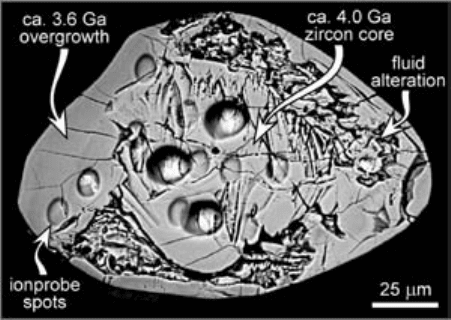
systematically scrutinized petrographically and chem-
ically. Constancy of element ratios, correspondence
between chemical variations and those predicted by
experimental data and petrographic observation,
preserved magmatic textures, and lack of second-
ary minerals are useful indications, but no proof, of
pristine condition. Generally less mobile elements
(Figure 2.22), including HFSE (Ti, Zr, Ta, Nb, Th),
REE (La to Yb), Al, and Mg, are more reliable for
petrogenetic interpretations.
Most Precambrian rocks are exposed in cratons;
these are large segments of continental lithosphere that
have remained coherent and geologically more or less
stable since their formative processes. Other more or
less synonymous terms for a craton are shield, block,
and platform. Cratons are made of one or more ter-
ranes in which the rocks have some degree of internal
petrologic and tectonic coherence. Obviously, any
relationship to then-prevailing plate boundaries and
processes, if they indeed were operative, has been
erased by younger events.
For our purposes here, the oldest rocks on Earth
are Archean. (According to the most recent geologic
time scale of Harland et al. (1990), pre-Archean, or
Priscoan, time pre-dates 4.0 Ga. Subsequent to this
publication, terrestrial rocks 4.0 Ga were dis-
covered.) Proterozoic time is 2500 to 570 Ma and
Phanerozoic time (Paleozoic, Mesozoic, and Cenozoic
eras) is 570 Ma.
The organization of this chapter follows a quasi-
chronologic order, beginning with Archean rocks
and following with Proterozoic rocks. Lastly, some
current and controversial ideas regarding the evolution
through time of the continental crust are considered.
Although magmatic rock-type names are used through-
out this chapter, it must be kept in mind that basalts,
granites, and so on are almost invariably metamorphosed
to some degree; accordingly the prefix “meta” is usually
implied.
19.1 THE YOUNG EARTH—A BRIEF
OVERVIEW
Accretion of the proto-Earth and other planetary
bodies in the solar system, as represented in datable
meteorites, is believed to have occurred at about
4.5 Ga (Allègre et al., 1995). Production of heat during
transformations of kinetic and gravitational potential
energy during accretion and differentiation of a denser
metallic core from a silicate mantle, supplemented by
decay of short-lived isotopes of
56
Fe and especially
26
Al, was sufficient to melt at least the upper mantle
(Bickle, 1990). The apparent similarity between the
composition of the mantle of the Earth and that of the
whole Moon and its relative depletion of volatiles, as
well as other arguments, have led to the hypothesis that
the Moon was ejected from the proto-Earth after core
segregation during the impact of a Mars-sized object. If
such an impact did indeed occur, the energy input into
the proto-Earth would have been sufficient to create
extensive melting and formation of a “magma ocean”
(see, for example, Tonks and Melosh, 1993). It is
further thought that the primeval crust on this magma
ocean was likely remelted and recycled by vigorous
convection and intense meteorite bombardment until
about 3.8 Ga. (Meteorite bombardment of Earth is
assumed because of the presence of widespread craters
of this age on the adjacent inner planets of the solar
system and the Moon.) This primeval heat was retained
through much of the infancy of the Earth when mantle
temperatures were estimated to be as much as 200–
300°C greater than at present (Abbott and Hoffman,
1984; Bickle, 1990). However, these estimates are
model-dependent, subject to future revision, and not
universally accepted. Campbell and Griffiths (1992),
for example, conclude the early mantle was no hotter
than at present.
Minute fragments of this earliest primeval crust may
be represented in detrital zircons as old as 4270 Ma
found in 3000 Ma quartzites and metaconglomerates
in Western Australia (Maas et al., 1992). Trace element
compositions of the zircons are consistent with a
612 Igneous and Metamorphic Petrology
19.1 Back-scatter electron microscope image of a complexly zoned
zircon from the tonalitic Acasta Gneiss Complex, Slave
Province (Figure 19.27), Northwest Territories, Canada. The
polished surface of the grain was etched in HF acid vapor to
enhance internal textural details such as the barely visible
oscillatory zoning in the magmatic core (high Th/U ratio)
overgrown by an unzoned metamorphic rim (low Th/U ratio)
and areas of late fluid alteration. Oval “shadows” are pits
sputtered off (excavated into) the polished surface by the ion
beam of the SHRIMP. Isotopic analysis of sputtered mater-
ial from three spots within the zircon core yielded an age of
4028 21 Ma. The metamorphic rim of the grain yielded an
age of about 3600 Ma. The three deeper pits in the core were
revisited with a higher intensity beam for in situ trace element
analysis. Image courtesy of Richard Stern and Wouter Bleeker,
Geological Survey of Canada, Ottawa.
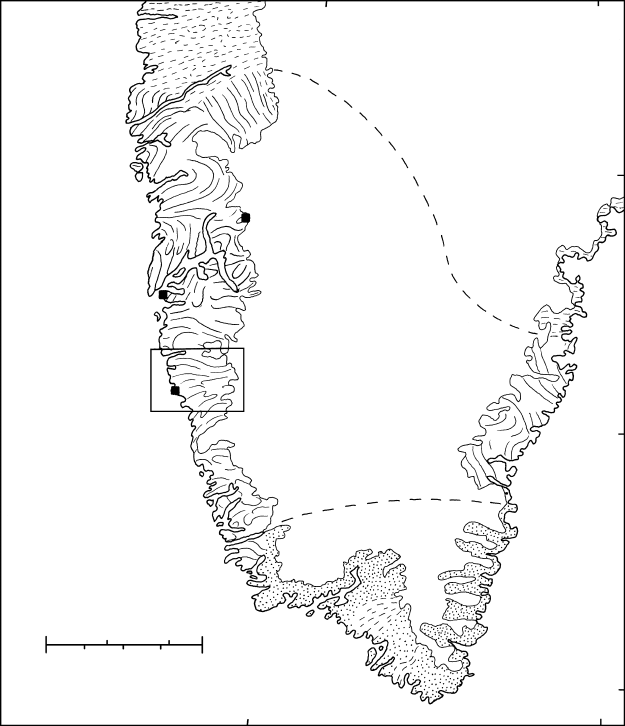
granitoid source, while 3900 Ma overgrowths imply
further crystallization deep in a differentiated contin-
ental source of substantial thickness.
The oldest known rocks on Earth are the Acasta
orthogneisses (metatonalite and metagranodiorite)
exposed over an area of only about 40 km
2
in the Slave
Province of northwestern Canada (see Figure 19.27)
that contain zircons as old as 4030 Ma (Special
Interest Box 19.1; see also Stern and Bleeker, 1998;
Bowring and Williams, 1999). Other rocks 3.8 Ga are
preserved as small scraps totaling only a few 100 km
2
in West Greenland (Figure 19.2) and nearby north-
ern Labrador as well as China and Antarctica. Rocks
3.6 Ga are exposed over an aggregate area of about
6000 km
2
in Ukraine, Western Australia, and South
Africa, in addition to the locales of 3.8 Ga rocks.
Virtually all rocks 3600 Ma are high-grade meta-
morphic rocks of the amphibolite and granulite facies,
many of which have been substantially modified during
younger events. Accordingly, their original nature can
be highly speculative.
19.2 ARCHEAN GRANITOID–
GREENSTONE TERRANES
Remnants of the oldest crust exposed in Archean
cratons consist of basically three components (Good-
win, 1996). About 10% is a supracrustal sequence of
volcanic and sedimentary rocks deposited in mostly
aqueous environment on the surface of the Earth and
about 60% is a plutonic suite of tonalite, trondhjemite,
and granodiorite (TTG) of roughly the same age as the
supracrustal sequence. Both have been recrystallized
and deformed to varying degrees, locally very strongly.
The supracrustal rocks typically lie in elongate, in-
folded synformal belts between domical masses of
TTG orthogneiss (Figures 9.14, 19.3, 19.6–19.8). Be-
cause the predominantly mafic rocks in these belts have
Precambrian Rock Associations
613
48°N
Isua
Godthåb
Fiskenæsset
Archean
gneisses
40°W
66°N
63°N
60°N
40°N
Archean (?) gneisses
intruded by
Proterozoic
plutons
Proterozoic
rocks
48°W
200km0
100miles0
19.2 Precambrian rocks of southern Greenland exposed along glacier-free coastal areas. Foliation in gneisses shown by thin lines, dashed
in Proterozoic rocks. Stippled pattern is granitic rocks. Rectangle encloses area of Figure 19.21a. Redrawn from Myers (1976). These
exposures are in the central part of the North Atlantic Craton that was rifted apart during opening of the Atlantic Ocean (Figure 13.23);
the western part is exposed in Labrador and the eastern in the British Isles.
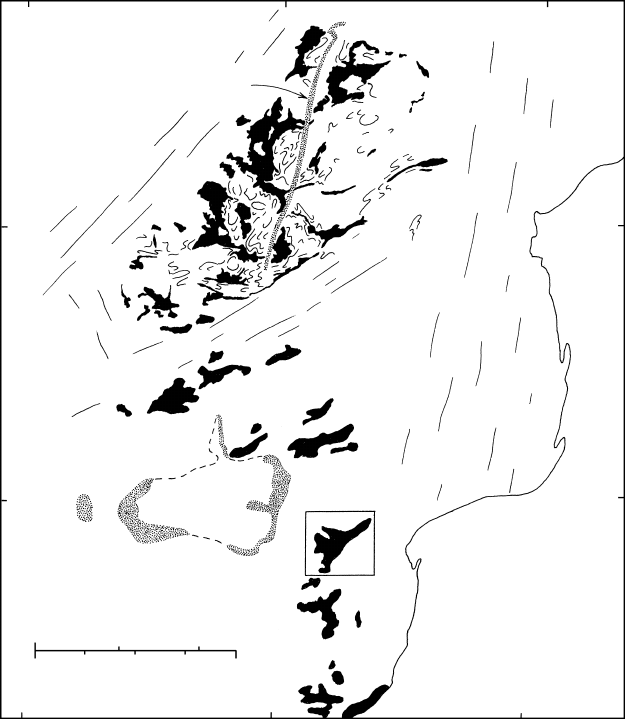
been metamorphosed into greenstones under typically
greenschist-facies conditions, they are referred to as
greenstone belts. These have been extensively char-
acterized in the 800-page compendium edited by de
Wit and Ashwal (1997). Some TTG plutons were in-
truded as magma into the supracrustal rocks, whereas
others served as a platform onto which the supracru-
stal rocks were deposited. In many places, the con-
tact between orthogneisses and supracrustal rocks is
tectonic (sheared or faulted).
About 30% of Archean terranes is a younger
suite of calc–alkaline, potassic granites that are now
orthogneisses that are generally less metamorphosed
than the TTG orthogneisses.
Ongoing field and laboratory investigations of
Archean granitoid–greenstone terranes are attempting
to resolve several basic questions. Are Archean con-
tinental and oceanic crust represented in granitoids of
the TTG suite and greenstones, respectively? Or, does
the typically higher grade of metamorphism of the for-
mer versus the lower grade of the latter simply signify
fundamentally different crustal types, or perhaps sim-
ply different levels of erosion? Do Archean basalts in
greenstone belts resemble modern oceanic ridge basalts
(MORB)? Or, are they more similar to subduction-
related island arc, back-arc, or plume-related oceanic
plateau basalts? Or, are they unlike rocks in any of these
more recent tectonic settings? Can greenstone belts be
compared to Mesozoic accreted terranes of oceanic rocks?
19.2.1 General Character of Greenstone Belts
Virtually all continents are host to small fragments of
Archean greenstone belts 3000 Ma. But younger
greenstone belts are widespread and many geologists
have recognized what they believe to be Phanerozoic
greenstone belts (de Wit and Ashwal, 1997).
614 Igneous and Metamorphic Petrology
25°S
20°S
Ocean
Craton
35°E
Zimbabwe
25°E
Great Dyke
Belt
Mobile
Limpopo
Bushveld
Complex
Craton
Kaapvaal
Indian
35°E
0
0 km 400
miles 200
19.3 Southeastern Africa showing Archean greenstone belts (black) in the Zimbabwe and Kaapvaal Cratons with their bordering and
transecting Proterozoic mobile belts (long lines). Trend lines in part of the Zimbabwe Craton show form of foliation in largely
tonalite–trondhjemite–granodiorite (TTG) gneiss domes between greenstone belts. Stippled areas are mafic–ultramafic intrusive rocks of
the Great Dyke and Bushveld Complex. Box to east of Bushveld Complex encloses Barberton Greenstone Belt shown at larger scale in
Figure 19.4. Redrawn from Hunter and Hamilton (1978) and Phaup (1973).
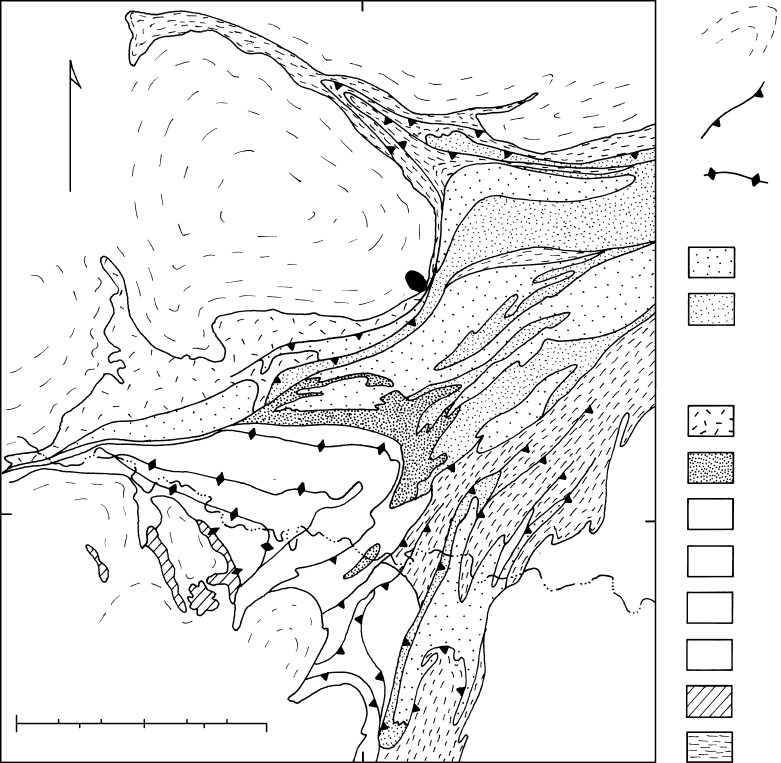
Most supracrustal greenstone sequences are 5–10 km
thick (e.g. Figure 19.5) but commonly polyphase
folding (e.g. Figure 19.7) and apparent stacking of
thrust sheets hinder assessment of original stratigraphic
thicknesses. This style of deformation indicates hor-
izontal shortening in the Archean crust that is consist-
ent with, but does not prove, lateral plate motion; that
is, seafloor spreading.
The oldest rocks in greenstone belts are commonly
metamorphosed tholeiitic basalt. Many belts also have
minor proportions of ultramafic komatiite (discussed
later). Both were intruded as sills and extruded as lava
flows, many of which were subaqueous, forming pil-
low lavas and hydromagmatic volcaniclastic deposits
(Sylvester et al., 1997). Distinctive shallow-marine de-
posits of accretionary lapilli and ash are traceable up to
30 km along strike. Andesites are a minor rock type in
Archean greenstone belts except for thick sequences in
the Superior Province of Canada (Figure 19.8) and in
the Yilgarn block of Western Australia (Figure 19.6),
where they form thick lava-debris-flow sequences sim-
ilar to those in modern composite volcanoes. Silicic
lava flows and volcaniclastic deposits are volumetric-
ally minor in all Archean terranes; they tend to occur
in the upper parts of greenstone sequences, overlying
the older basaltic part. Proterozoic greenstones belts
generally contain more andesite and felsic volcanic
rocks than most Archean and the amount of associated
sedimentary rock increases with decreasing age through
the Precambrian (Condie, 1994). This suggests a
gradual trend from submarine basalt–komatiite lava
plains or oceanic plateaus during the Archean to
more evolved composite volcanoes that emerged above
sea level during the Proterozoic.
Study of the metamorphism in greenstone belts
has lagged behind that of other terranes. A paradox
Precambrian Rock Associations
615
Granitoid plutons
(orthogneiss), mostly
TTG; age in Ma
Thrust fault; teeth
on upper plate
Subvertical fault
or shear zone
Moodies Group
Mostly sedimentary rocks
Mostly mafic-ultramafic volcanic
rocks, lesser felsic; minor chert
Fig Tree Group
Weltevreden Formation (3290)
Mendon Formation (3300)
Kromberg Formation (3420)
Hoogenoeg Formation
Kr
H
Komati Formation
Ko
Theespruit Formation (3540)
Sandspruit Formation
Undivided volcanic rocks
T
20miles
25
3437
3481
3180
3227
Barberton
3250
31°E
N
T
T
H
Kr
Ko
H
H
26°S
Kr
Kr
Komati River
T
T
Ko
H
T
km
0
0
19.4 Barberton Greenstone Belt and surrounding orthogneiss domes in southern Africa. See Figure 19.3 for location. Domes are metamor-
phosed granitoid plutons, mainly of TTG. Rock units (Moodies is youngest, Sandspruit oldest; ages in Ma) are highly generalized, as are
faults. Redrawn from Lowe and Byerly (1999) and de Wit et al. (1992).
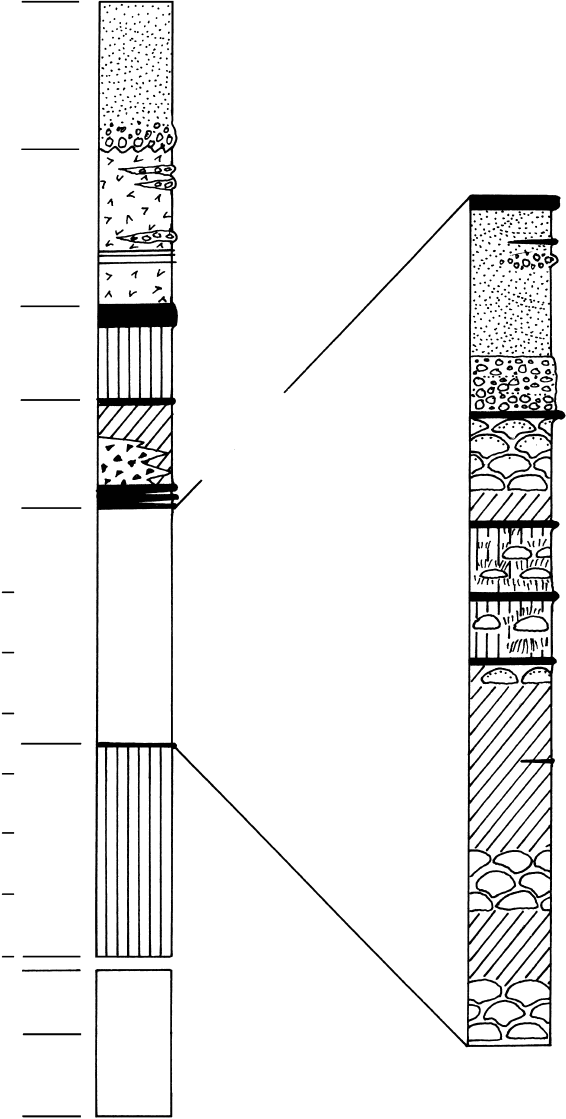
616 Igneous and Metamorphic Petrology
6 km
4
2
0
Theespruit
Formation
Basalt and komatiite intruded
by early Archean TTG
Komatiite
Pillow
basalt
Tholeiitic
basalt
lava flows
Komatiitic basalt
with pillows and
spinifex fabric
Pillow
basalt
Basalt lava
flows
Basaltic
volcaniclastic rocks
Chert (massive)
Chert (thin bedded)
Volcaniclastic rocks
Conglomerate
Sandstone
Moodies GroupFig Tree GroupHooggenoeg FormationKomati Formation
Mendon
Formation
Kromberg
Formation
Komatiite
Sandspruit
Formation
19.5 Stratigraphic section for the southern Barberton Greenstone Belt, South Africa. Column on the right is an expanded view of the Hoogge-
noeg Formation. Redrawn from Lowe and Byerly (1999).
in some belts is an apparent lack of progressive
increase in grade with depth, despite stratigraphic
thicknesses of many kilometers. Major points of the
metamorphism of greenstone belts include (Wilkins,
1997):
1. Facies range from prehnite–pumpellyite through
greenschist to amphibolite and locally to the gran-
ulite (Figure 19.9). Rocks of subgreenschist and
greenschist facies are the most widespread. Retro-
grade effects are common.
